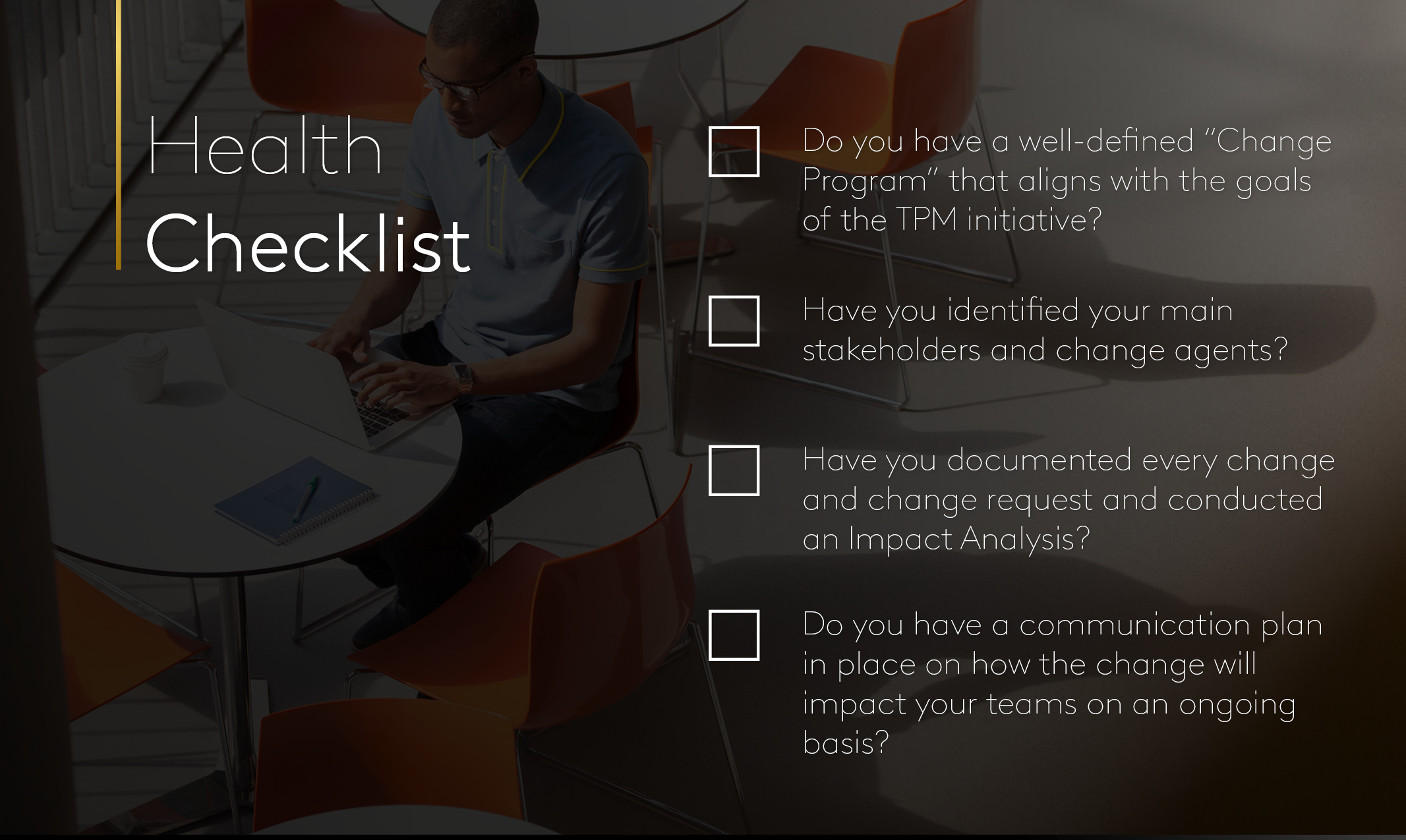For those of you that are currently working with a TPM system, you know that driving successful trade promotion outcomes is contingent upon strong user adoption. Without user adoption, user behaviours and actions do not evolve as planned. You risk any return on investment for your TPM digital transformation program and add the cost of having to “fix it later.” Preparing your teams to the coming changes to help drive adoption is necessary to ensure successful TPM outcomes – but it is easier said than done. This task requires a strong change management strategy that is embedded into the TPM design, to boost your chances of success.
When executed correctly, embedding change management best practices produces a slew of benefits. It reduces the productivity gap that results from rapid changes to ways of working, lessens the impact on individuals by reducing uncertainty, and increases the level of engagement and commitment to the change.
If you need help setting up your own Change Management program or want to assess the state of your current program, here are few questions to get you started.

People
A certain level of resistance is to be expected when big changes are taking place, which is why mitigating concerns through a series of actions is an important component of a change management program. This can take place in the form of newsletters, trainings, setting up office hours and conducting town halls to ensure there is visibility into the changes taking place. More personalised sessions through one-to-one meetings or small group settings are vital, so each stakeholder can voice concerns without fear of rebuke.
Stakeholders should also have dedicated time to focus on change responsibilities in addition to their current job. This may require reassigning work or other projects to create enough bandwidth for everyone to dedicate attention to the communications and training. This will pay off later as any confusion behind the “why” of each change will already have been addressed.
Another driving force for change will be your change agents. Once the project goes live, identify your “star players”, those who have embraced the changes and adopted the new processes in stride, and let them be an evangelist for the new way of working. This peer-to-peer testimony, and even training, will be your greatest adoption accelerant, so keep your ears to the ground for your change agents.
“Do not underestimate the capabilities as you are driving change. TPM is really bringing this forward-looking data to life, but forward-looking even at the lowest level…You need the capabilities in doing so. And you need to help your sales teams in getting those capabilities.” – Kellogg’s
Processes
Even the smallest of changes that take place in the design phase of a TPM project can amount to a huge impact on the end users. Each change can completely reshape a process, which puts the onus on the end user to adopt a new way of working and the team leads to drive the adoption. Without the benefit of the change in clear sight, the end user might revert to pre-implementation ways of working, preventing the intended efficiencies of the TPM system.
The main topic to emphasise and demonstrate in every form of communication you provide (be that a town hall, newsletter, or one-to-one training) are the benefits and the convenience of the new processes. The relevancy of benefits will vary from person to person. Though it is very important to communicate high level benefits that pertain to the many, such as those that come from operating on “a single source of truth”, it is even more crucial to convey benefits that come at the individual level. This will answer the “what’s in it for me” question and be people’s main motivator. When it’s clear that the new processes (consolidated on a single source of truth) will save them time and effort, rid them of nuisances such as tracking information over email, and help them speedily reach their objectives with confidence – the adoption rate will go up.
“People didn’t want to change their ways of working. We should have had a solid Change Control Board so we could have had a steering guide to refer too… at the end of the day your project team should support the process change rather than spending time on a change request.” – Kellogg’s
Data
The root of most changes to processes and ways of working (and the outcomes of those processes) comes from changes to data, usually through cleaning or restructuring.
During the design phase, all key stakeholders should be brought into those conversations from the beginning to agree upon the data change, its intended goal, and the impact it will have on the end user. It’s best practice to map each change to the functional area it is impacting, each stakeholder using or leveraging that data, and what the goals are for that change. This level of visibility will aid the decision-making process during the design phase, ensuring the benefit of the change outweighs the added complexity to the end user and the process. It will also help lock in stakeholder buy-in and support of the change management efforts once the project goes live.
“Have a stakeholder brainstorming session. You will be surprised by the names that will come up of people that need to have input so all systems sync properly. Some people will have a lot of power, and some have less interest, so you need to communicate clearly and regularly so they can engage and stay on your side when they need to.” – Kellogg’s
Best Practices
Communication plans – Establish clear and ongoing communication plans and get them out early so your teams know what is changing, what is not changing, why it’s changing, and how they will be directly impacted. This reduces confusion and frustration and increases the rate of adoption.
Impact Assessment – In order to clearly communicate the “change plan” with your teams, it’s important to conduct an impact assessment first that determines what is changing, who it impacts, and the degree of difficulty to overcome to then understand what training should be arranged.
Agree on changes early – When making re-structuring and cleaning data, bring in the right stakeholders from the beginning to ensure you have support and buy-in for those changes later
Define the individual benefits – Success is different for every stakeholder. To motivate at the individual level, define how that change will benefit each stakeholder and they will turn into an active proponent of that change.
As mentioned in the Digital Transformation Webinar Series, “you can’t do today’s job with yesterday’s methods and be in business tomorrow.” With a solid change management program in place, you can open up your teams to a new technology and drive future-facing, lasting growth.
Access our webinar, featuring Bel and Kellogg’s, which covers their implementation perspective in hindsight.


